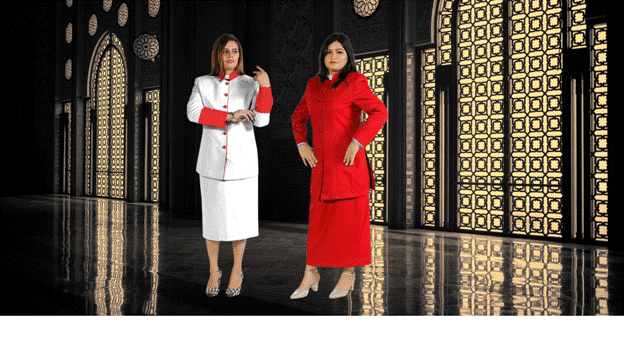In religious practices around the world, attire plays a significant role. For women in ministry, clergy dress is not just about appearance, it is a powerful symbol of faith, authority, and the sacred duty they perform. Throughout history, clerical clothing has held deep meaning, and today, it continues to be a reflection of religious identity. In this article, we explore the profound role that clergy dress for women plays within various religious traditions, its symbolism, and how it has evolved.
What is Clergy Dress for Women?
Clergy dress for women refers to the distinct attire worn by female members of the clergy across different religious denominations. This dress typically includes robes, stoles, and other vestments that symbolize the wearer’s role in ministry. Clerical clothing varies between Christian denominations, but regardless of the specific traditions, clergy attire serves as a visual representation of religious commitment and leadership.
The use of distinctive clothing for religious leaders is not a new concept. For centuries, clergy attire has been designed to distinguish those who lead worship, administer sacraments, and guide communities. For women, clergy dress marks their authority within the church and symbolizes their spiritual role.
The Symbolism Behind Clerical Clothing for Women
At its core, clerical clothing for women is symbolic of service and humility. The robe, often worn by female clergy members, represents the garment of Christ, who is viewed as the ultimate servant-leader. The simplicity of the attire reminds the wearer and the congregation of the sacred nature of the ministry and the call to serve others.
The color and style of the clerical attire can also hold symbolic meaning. For example, white robes may represent purity and holiness, while purple robes may symbolize penance or royalty. Stoles, which are worn over the robe, often correspond to the liturgical season or the specific role of the clergy member. For women in ministry, the choice of clothing can speak to both their connection to their faith and the broader religious community’s traditions.
The Evolution of Clergy Dress for Women
Historically, women in religious leadership positions were often excluded from wearing traditional clergy attire, as the role of religious leadership was primarily reserved for men. However, as women began to enter the ministry, particularly in Protestant denominations, the question of appropriate attire became increasingly relevant.
In the 19th and 20th centuries, women’s clergy attire began to evolve. Women clergy were initially limited to wearing the same attire as their male counterparts, but with time, distinct designs emerged that allowed women to express their individuality while still adhering to the traditions of their faith. Today, the clergy dress for women includes a variety of robes, stoles, and other liturgical garments that are both functional and symbolic.
This evolution is not just about clothing, it is a reflection of the changing roles of women within religious communities. As women have gained more visibility in religious leadership, their attire has become a way to mark their presence and authority, demonstrating that their spiritual and ministerial roles are just as important as those of their male counterparts.
Clergy Dress for Women Across Different Religious Traditions
Clergy dress for women varies significantly across religious traditions, each with its unique significance and practices. Let’s take a closer look at how clergy attire is adapted in different faiths.
Christian Traditions
In Christianity, the clergy dress for women has a long history that varies by denomination. In the Catholic and Orthodox traditions, women clergy members typically wear albs, stoles, and a chasuble special clergy dress which includes a skirt or a clergy shirt. These garments symbolize their role in administering the sacraments and leading worship. In some Protestant denominations, women may wear a cassock or robe, while others wear more contemporary clothing, reflecting the less formal liturgical style adopted by these branches of Christianity.
The robe or alb is the most common piece of clerical clothing for women in these traditions. It represents the garment worn by Christ and signifies purity and humility. A stole, worn over the shoulders, often signifies ordination and is used to symbolize the pastoral care and leadership of the clergy member.
Jewish Traditions
In Jewish tradition, the clergy attire for women, particularly within the Reform and Conservative movements, is typically more modest, consisting of long robes and a head covering. While women are not traditionally allowed to serve as rabbis in Orthodox communities, their leadership role has grown significantly in the Reform and Conservative Jewish movements.
For female rabbis, their clothing often includes a tallit (prayer shawl), which is worn during prayer services. In the early 21st century, female rabbis began wearing the same types of liturgical clothing as male rabbis, adapting them to fit the body and the role of a female clergy member.
Islamic Traditions
In Islam, the role of female clergy is distinct from Christian or Jewish clergy, but women have always played an important part in the spiritual life of the community. Although there is no formal “clerical dress” for women in Islam, many Muslim women who engage in religious leadership or education wear modest clothing that aligns with Islamic principles. The hijab, or headscarf, is commonly worn by female religious leaders, and in some cases, women wear abayas (loose-fitting robes) while leading prayer or teaching.
Clerical Clothing: A Reflection of Authority and Humility
Clergy dress for women is not only about fulfilling a religious or cultural obligation; it is also a reflection of their spiritual authority and humility. When women put on their robes and stoles, they are not simply dressing for church. They are physically embodying their commitment to their faith, their leadership within their community, and their calling to serve others.
For female clergy members, their attire serves as a constant reminder of the responsibilities they bear and the sacred nature of their work. The simplicity and solemnity of the clerical clothing ensure that the focus remains on the ministry, not the individual wearing the attire. This humility is central to the role of clergy in all faiths.
The Importance of Clergy Dress for Women in Modern Times
Today, the clergy dress for women remains a powerful symbol within religious communities. It not only honors the traditions of the past but also serves as a reminder of the ongoing evolution of women’s roles in religious leadership. For many women clergy members, their attire is a source of pride and a visual representation of their hard work, dedication, and faith.
In the modern era, clergy dress for women is evolving to include more options and styles that balance tradition with contemporary needs. This evolution ensures that women in ministry have access to attire that reflects their identity while honoring the historical and spiritual significance of their role.
Conclusion
Clergy dress for women is much more than just a uniform, it is a profound symbol of faith, authority, and service. Throughout history, women have adapted their clothing to reflect their unique roles in religious leadership, and as these roles continue to evolve, so too does the attire that accompanies them. Whether it is the simplicity of the alb or the symbolism of the stole, clergy dress for women remains a central part of religious traditions, marking the wearer as both servant and leader in their community.
By understanding the history and significance of clergy dress for women, we can appreciate the deep meaning it carries for those who wear it and the important roles they fulfill in their spiritual communities. It is a tradition that continues to grow, evolve, and inspire those who choose to serve in the ministry, and its importance will likely endure for generations to come.







